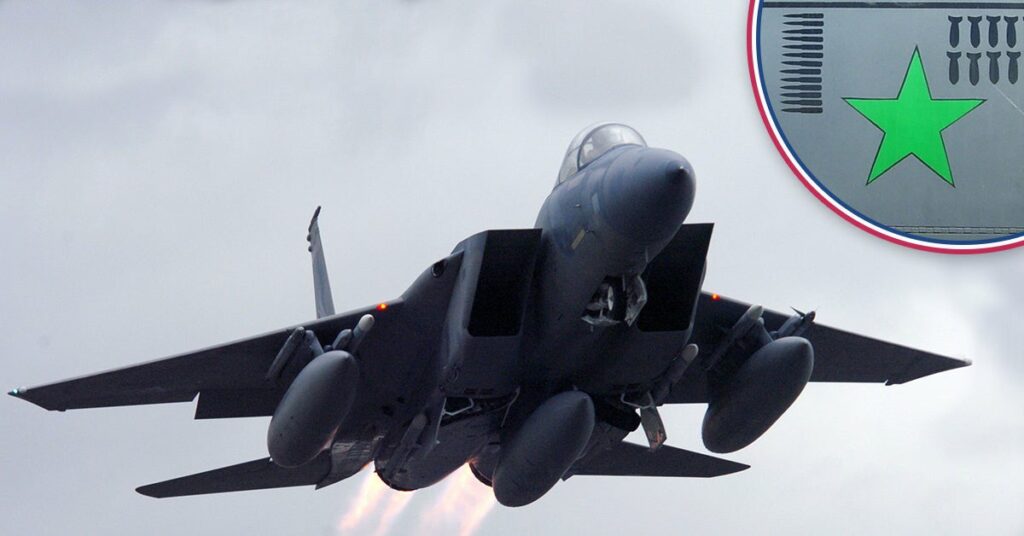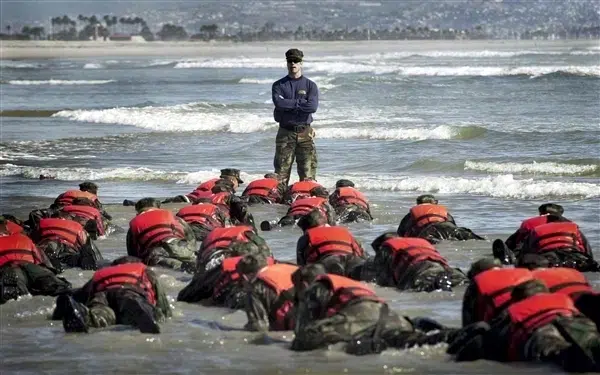Why do some Air Force fighters have a green star on them?
- By We Are the Mighty
Share This Article

In the Air Force fighter community, there is a coveted and rare marker painted near the cockpit of certain planes, just beneath the pilot’s name, rank, and call sign. It’s 6-inch green star with a 1/2-inch black border that signifies that the aircraft has emerged victorious against an enemy jet in aerial combat.
The Army Air Corps and U.S. Air Force have allowed pilots to mark their victories on their fuselages for decades, but the height of the tradition was during World War II when the frequent aerial combat combined with the sheer numbers of planes in the air at once led to dozens of pilots having to kill or be killed on any given day.
In that era of fierce fighting, the U.S. Army Air Corps allowed most pilots to mark their aerial victories with a small replica of the enemy pilot’s flag, placed beneath the pilot’s name on the fuselage. This was typically either a decal or a bit of paint applied by the ground crew. There were also some cases of fighter groups painting the silhouettes of the planes they had shot down.

(Pima Air and Space Museum)
Related: This Navy ‘ace of aces’ shut down a 60 plane attack
One U.S. pilot even boasted every Axis flag — as well as a single U.S. flag — on his cockpit. Yes, he shot down a U.S. plane and got a medal for it.
But, eventually, the use of flags, silhouettes, and some other markings fell out of favor when it came to aerial victories, though the Air Force does still allow bomber crews to use bomb silhouettes to mark their missions.
But for fighter pilots, it’s now all about the green star, standardized in Air Force Instruction 21-205 as:
“Aerial Victory Marking. Fighter aircraft awarded a verified aerial victory are authorized to display a 6-inch green star with a 1/2 inch black border located just below and centered on the pilot’s name block. The type of aircraft shot down shall be stenciled inside the star in 1/2 inch white lettering. For aircraft with multiple aerial victories, a star is authorized for each aircraft shot down. No other victory markings are authorized.”

Related: The first American to score an air-to-air kill wasn’t even supposed to be there
Modern aerial victories are rare, not because the U.S. loses but because the Air Force dominates enemy air space so hard and fast that typically only a handful of pilots will actually engage the enemy in the air before the U.S. owns the airspace outright. In Desert Storm, about 30 U.S. pilots achieved aerial kills in about 30 aircraft. At least two of those aircraft, the F-14s, have since retired.
Meanwhile, there are almost 2,000 fighter aircraft in the U.S. inventory. So, yes, the green stars are very rare. So rare, the air wings occasionally brag about the green-star aircraft that are still in their units.
The 455 Air Expeditionary Wing history department released an article in 2008 bragging that a green-star aircraft from Desert Storm was then in active service over Afghanistan. The aircraft on display above is the only F-15E to ever achieve an air-to-air kill, a feat it pulled off by bombing a helicopter as it took off, destroying the helicopter and the troops it had just dropped off.
In 2010, the 353rd Special Operations Group historian released an article about their F-15C with its own green star. The plane was used by a Marine pilot in an exchange program who shot down one of two MiG-29s attempting to attack an F-14 flying all alone and unafraid during Desert Storm.
Of course, aerial victories are even rarer today. In 2017, the Navy claimed America’s first air-to-air kill of an enemy aircraft since 1999. Or, in other words, we’ve had only one aerial victory in almost 20 years. In the 2017 engagement, two U.S. Navy FA/-18E Super Hornets attacked a Syrian Su-22 fighter that was dropping bombs near forces friendly to the U.S.
For anyone wondering about how we invaded two countries at the start of this century without shooting down any enemy aircraft, Iraq lost most of its aircraft during Desert Storm and the following year while Afghanistan had no real air force to speak of in 2001. Most aircraft destroyed in Syria were killed on the ground.
So, no green stars there.
Read more from Sandboxx News:
- 5 odd military traditions most people don’t know about
- 6 military superstitions, their history and significance
- 9 things you didn’t know about the US Air Force
- 11 US military history facts that might just intrigue you
- Why even F-35 pilots still have to fly ‘by the seat of their pants’
This article by Logan Nye was originally published by We Are the Mighty. Follow WATM on Facebook.
Feature image: WATM Composite-U.S. Air Force photo/Senior Airman John Hughel and U.S. Air Force/ James D’Angina
Related Posts
Sandboxx News Merch
-

‘AirPower’ Classic Hoodie
$46.00 – $48.00 Select options This product has multiple variants. The options may be chosen on the product page -

‘Kinetic Diplomacy’ Bumper Sticker (Black)
$8.00 Add to cart -

‘Sandboxx News’ Trucker Cap
$27.00 Select options This product has multiple variants. The options may be chosen on the product page
We Are the Mighty
Related to: Airpower

This is why the Marine Corps is different

Heroic Coast Guard rescue swimmer saved hundreds in Texas floods and exemplified the spirit of America

BUD/S instructors have their favorite games to make SEAL candidates suffer

Air superiority is a required component in modern warfare
Sandboxx News
-

‘Sandboxx News’ Trucker Cap
$27.00 Select options This product has multiple variants. The options may be chosen on the product page -

‘AirPower’ Classic Hoodie
$46.00 – $48.00 Select options This product has multiple variants. The options may be chosen on the product page -

‘AirPower’ Golf Rope Hat
$31.00 Select options This product has multiple variants. The options may be chosen on the product page -

‘Sandboxx News’ Dad Hat
$27.00 Select options This product has multiple variants. The options may be chosen on the product page
